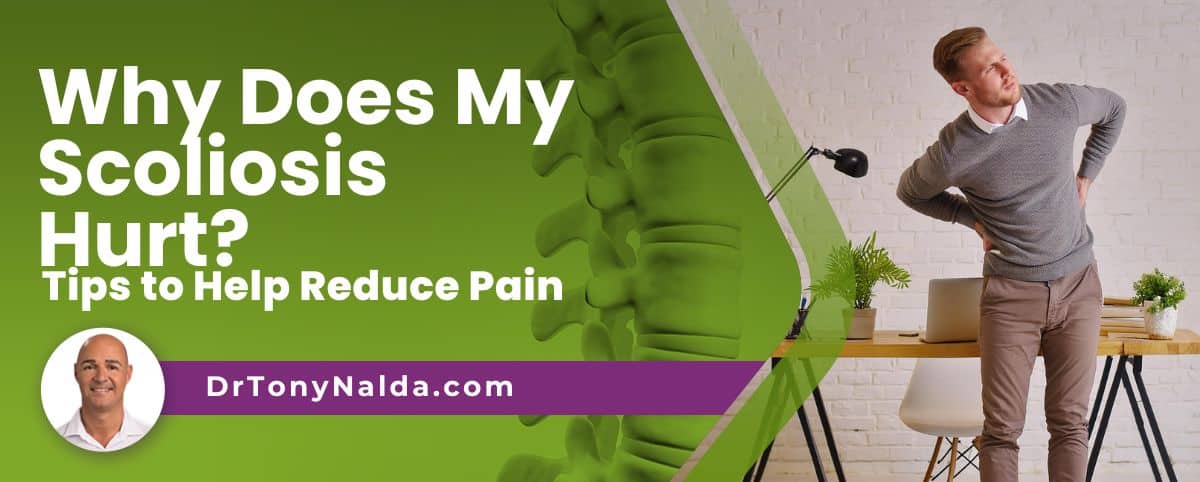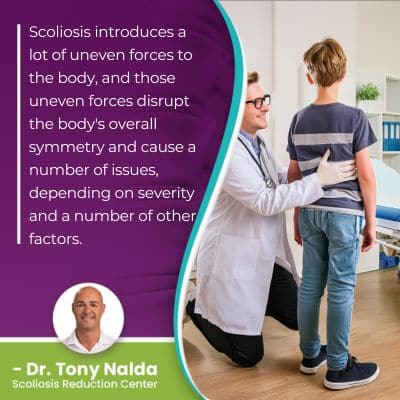Why Does My Scoliosis Hurt? Tips to Help Reduce Pain

Scoliosis can hurt in different ways, but the most common involve muscle, back, and nerve pain, and this is caused by the condition's uneven forces, and once the condition becomes compressive, it tends to be painful. Scoliosis pain can also get worse alongside progression.
Scoliosis ranges widely in severity, and symptoms like pain will also differ from patient to patient. Scoliosis pain can include muscle pain, back pain, and pain that radiates into the extremities due to nerve compression. Compression is the main cause of scoliosis pain.
Let's talk about how scoliosis affects the body in general, before focusing on scoliosis pain as a symptom.
Table of Contents
How Scoliosis Affects the Body
The spine's natural and healthy curves make it stronger, more flexible, and better able to handle mechanical stress, and scoliosis causes the development of an unnatural spinal curve that bends to the side and also twists, making scoliosis a 3-dimensional condition.
 Scoliosis introduces a lot of uneven forces to the body, and those uneven forces disrupt the body's overall symmetry and cause a number of issues, depending on severity and a number of other factors.
Scoliosis introduces a lot of uneven forces to the body, and those uneven forces disrupt the body's overall symmetry and cause a number of issues, depending on severity and a number of other factors.
Scoliosis affects all ages as congenital scoliosis that babies are born with due to a malformed spine developing in utero, infantile scoliosis, early-onset juvenile scoliosis; the most common type overall is adolescent idiopathic scoliosis, diagnosed between the ages of 10 and 18, and adult scoliosis is diagnosed once skeletal maturity has been reached.
There are also different types of scoliosis a person can develop, and type is based on causation.
Scoliosis is Progressive
Scoliosis is a progressive condition, meaning its nature is to get worse over time, and this means the size of the unnatural spinal curve will increase, as will its effects.
So where a scoliosis is at the time of diagnosis doesn't mean that's where it will stay, especially if left untreated, or not treated proactively.
We don't always know what causes scoliosis to develop initially, but we do understand that it's growth that triggers progression, so as children grow, they are vulnerable to progression, particularly adolescents who are in the stage of puberty.
Scoliosis ranges in severity from mild scoliosis to moderate scoliosis, severe and very severe scoliosis, and this is also the condition's progressive line; the goal of proactive treatment is to prevent scoliosis from getting worse and to prevent scoliosis surgery from being necessary.
The effects of scoliosis will increase and become more noticeable as a condition progresses, and in children, the main effects involve postural changes (uneven shoulders, uneven waistline, rib cage arch, one shoulder blade protruding more, arms and legs that appear to hang at different lengths), and in adults, the main symptom of scoliosis is pain, so let's talk about the different types of pain scoliosis can cause.
Scoliosis Pain
As mentioned, the main scoliosis effects in children involve postural deviation, and as childhood scoliosis isn't compressive, pain isn't considered a common symptom of childhood scoliosis.
Scoliosis becomes a compressive condition once skeletal maturity has been reached; when the spine is still growing, it's undergoing a constant lengthening motion that counteracts the compressive force of the unnatural spinal curve.
Compression is uneven pressure, and compression of the spine and its surrounding muscles and nerves is the main cause of scoliosis pain.
In adults, scoliosis pain can feel like localized back pain and, most often, pain that radiates into the extremities due to nerve compression.
When it comes to scoliosis back pain, the area of the back and body located the closest to the scoliotic spinal section is going to feel the majority of the condition's direct effects.
Curvature Location
There are three main spinal sections, and scoliosis can develop in any one section, or in more than one as a combined scoliosis: the cervical spine (neck), thoracic spine (middle/upper back), and the lumbar spine (lower back).
So if scoliosis develops in the lumbar spine, the condition's main effects will be felt in the lower back and body; for example, a common complication of lumbar scoliosis is the development of sciatic nerve pain because the sciatic nerve starts in the lumbar spine.
If the unnatural curve in the lower back is compressing the sciatic nerve, pain can be felt anywhere along its extensive pathway that starts in the lower back and extends down the hip, buttock, leg, and into the foot.
So back pain can be felt in the area of the unnatural spinal curve, and the area of the body located the closest to the affected spinal section, and nerve pain is also common as the spine contains 31 pairs of spinal nerves that can be vulnerable to compression and becoming pinched nerves.
Scoliosis pain can range from chronic back pain to mild and intermittent and can also include arm and leg pain, so for adult scoliosis, pain relief is a focus of treatment as adult scoliosis patients tend to experience the most scoliosis pain.
As it's not just the spine that has to maintain its natural curves and neutral alignment, but also the spine's surrounding muscles, muscle pain can also be common.
Scoliosis Muscle Pain
 The spine is surrounded by muscles that provide it with support and stabilization.
The spine is surrounded by muscles that provide it with support and stabilization.
As a scoliotic curve develops, it's not just introducing uneven forces to the spine itself, but also its surroundings, and this includes muscles.
A common effect of scoliosis that can cause painful muscle spasms is a muscular imbalance; as the spine's unnatural curve pulls its surrounding muscles in different directions, muscles on one side of the spine can become weak from underuse, while muscles on the opposite side can become stretched and sore from overuse.
Muscles that are weak and/or overused are going to be painful, and physical therapy can help address chronic pain caused by sore and unbalanced muscles by strengthening core muscles (abdominal muscles) for better spinal support and to relieve pressure on the spinal canal and its nerves within.
So scoliosis can hurt in different things, from nerve and back pain to muscle pain, and in addition, scoliosis can also be associated with painful headaches and migraines.
Headaches and Migraines
Scoliosis can cause some surprising effects, one of which are headaches that can reach migraine severity, and this is due to cerebrospinal fluid (CSF).
Cerebrospinal fluid flows in and around the spinal cord and brain to provide cushioning, protection, and provide essential nutrients.
When the spine has an unnatural curvature, this can also affect a person's level and flow of CSF in and around the spinal cord and brain, and this can be associated with painful headaches and migraines.
The more severe scoliosis is, and the longer it's left untreated, the more noticeable its effects are likely to be, and the more necessary an effective treatment plan is.
The best way to minimize the potential effects of scoliosis, including pain, is through proactive treatment options.
Conclusion
So why does scoliosis hurt? It's important to understand that each patient has their own unique experience of scoliosis symptoms based on important patient/condition factors such as patient age, condition type, severity, and curvature location.
When scoliosis is painful, this most often involves adults as scoliosis doesn't become a compressive condition until skeletal maturity has been reached.
For adults, scoliosis pain commonly involves back pain, muscle pain, and nerve pain, and while children don't commonly experience a lot of back pain, muscle pain is common.
In addition, scoliosis is also associated with headaches and migraines due to disruptions to the flow of cerebrospinal fluid in and around the brain and spinal cord, and the best way to address scoliosis pain for long-term sustainable results is through a proactive scoliosis treatment approach.
Scoliosis pain can be addressed by impacting the underlying structural nature of idiopathic scoliosis, just as the underlying condition causing the development of neuromuscular scoliosis has to be addressed to impact its symptoms.
Scoliosis pain can also be improved through a healthy spine-friendly lifestyle that includes maintaining a healthy weight, activity level, diet, practicing good posture, proper lifting of heavy objects, and limiting alcohol consumption and/or smoking.
Here at the Scoliosis Reduction Center, my patients benefit from a conservative scoliosis treatment approach that works towards minimizing condition effects like pain through proactively preventing progression.
Through the combination of chiropractic care, physical therapy, corrective bracing, and rehabilitation, conditions can be impacted on every level so condition effects are minimized as the condition's underlying structural nature is addressed and core muscles are strengthened for improved spinal support/stabilization.
Particularly with early detection and intervention, progression and the need for scoliosis surgery can be avoided, giving patients the best potential quality of life.
Dr. Tony Nalda
DOCTOR OF CHIROPRACTIC
After receiving an undergraduate degree in psychology and his Doctorate of Chiropractic from Life University, Dr. Nalda settled in Celebration, Florida and proceeded to build one of Central Florida’s most successful chiropractic clinics.
His experience with patients suffering from scoliosis, and the confusion and frustration they faced, led him to seek a specialty in scoliosis care. In 2006 he completed his Intensive Care Certification from CLEAR Institute, a leading scoliosis educational and certification center.
About Dr. Tony Nalda
 Ready to explore scoliosis treatment? Contact Us Now
Ready to explore scoliosis treatment? Contact Us Now





